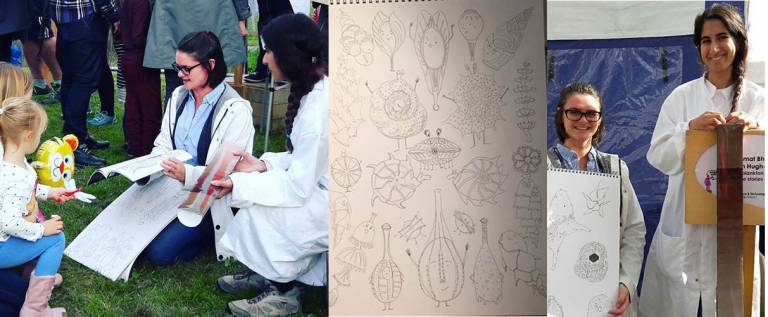Soapbox Science: Art and Science 2017
20 December 2017
"Foraminifera, deep time climate change and the HMS Challenger expedition" by Rehemat Bhatia, PhD student.

Soapbox Science is an international public outreach platform supported by the Science and Technology Facilities Council (STFC), L’Oréal and the Zoological Society of London (ZSL). Different public spaces are transformed into areas similar to London Hyde Park’s Speaker’s Corner, and members of the public can stop to hear all about exciting scientific initiatives and ask questions. Founded by two women scientists, Seirian Sumner (UCL) and Nathalie Pettorelli (ZSL), Soapbox Science aims to promote women in science and the research they do. So far, it has been launched in UK, Canada, Australia, Italy, Ireland and Germany.
This year, Soapbox Science launched a new initiative where they challenged artists and scientists to work together to produce pieces of artwork inspired by science. During September 2017, I took part in the London Art and Science event at the Thamesmead Festival in east London, collaborating with a friend (Helen Hugh-Jones) who runs an art company called Nell’s Originals, as well as working for an interior design company in London. The science packed event featured a range of scientific topics including fetal biomechanics, theoretical physics, ecosystem dynamics, climate change, oncology and cosmology.
Our Soapbox presentation was focused around foraminifera, deep time climate change and the HMS Challenger expedition. I wrote a short talk, and Helen produced a flipchart with lots of beautiful sketches to go with it as a ‘storybook’. The sketches were inspired by the work of Ernst Haeckel, a German biologist who worked on the HMS Challenger samples, and a micropalaeontology SciArt icon. If you haven’t read his “Art Forms in Nature” book it’s definitely worth a read! We also used CT scan data sent to us by Ellen Thomas at Yale University to create 3D printed foraminifera (printed at UCL MakeSpace). These models and a fake sediment core showing the Paleocene Eocene Thermal Maximum were brilliant for engaging the little scientists in the audience. The combination of physical and artistic representations of foraminifera meant we could really bring them to life and essentially ‘make the invisible visible’.
Soapbox Science is an event I’ve known about ever since undergrad, and I’ve always wanted to participate – it was so exciting to be chosen for this year’s Art and Science event, and hopefully Helen and I were able to inspire more young people to go into science. I would thoroughly recommend taking part to everyone in the department – it’s loads of fun and a great experience!
 Close
Close

